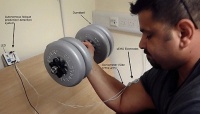A prototype system has been devised by Mohamed Al-Mulla, in PhD research at Essex University’s School of Computer Science and Electronic Engineering.
During training, athletes generally have to rely on their own perception of muscle fatigue — clinically defined as a reduction of the ability of a muscle to contract and exert force.
Localised muscle fatigue can be beneficial in promoting muscle growth or potentially harmful, causing strain and injury. Often it’s a fine line and timing is crucial, said Al-Mulla.
‘What I want to do is build a bridge between the brain and the muscle,’ he added.
‘When you go the gym, why do you do 10 reps of something? Why not more? Why not less? It’s quite arbitrary when you think about it. I train myself and sometimes I don’t even feel like doing three but I know I can do more.’
To acquire input data, the system uses surface-electromyography (sEMG) electrodes to detect electrical signals as muscles contract and a goniometer to measure kinematics as muscle fatigue can manifest itself as small oscillations or vibrations.
Signals from the muscles are then amplified and converted from an analogue-to-digital stream using a commercially available platform called Sunspot, produced by Sun Microsystems.
In order to test and calibrate the system, Al-Mulla and his team asked five male gym users to perform a resistance exercise, in this case seated bicep curls, while hooked up to the sensors and amplifier. They were then asked to exert force for as long as possible.
Analysing data, the team found that the onset of fatigue occurred in several distinct phases — what Al-Mulla calls ‘transition to fatigue’.
‘You can scale it from one to 10, so the closer to 10 you are, the closer to fatigue you are and the faster you will get there. Once you detect the onset of transition to fatigue then you can calibrate it with a timer, so I can tell the user, for example, “in 30 seconds you will stop”.’
The next stage will be to make the components more discrete and portable, and Al-Mulla is already working on plasters that can be placed on the relevant muscle then communicate wirelessly with an iPhone.
Wearable computing has been applied in various fields, in particular within the healthcare sector to monitor the health and the welfare of patients, where movements and behaviours are studied.
In keeping with this, Al-Mulla said his system can also be applied in occupational health and ergonomics, in particular where there is a risk of work-related musculoskeletal disorders such as repetitive strain injury.






Poll: Should the UK’s railways be renationalised?
I _do_ remember British Rail - and that it was <i>literally</i> a national joke https://youtu.be/zV2lmSDKvO8